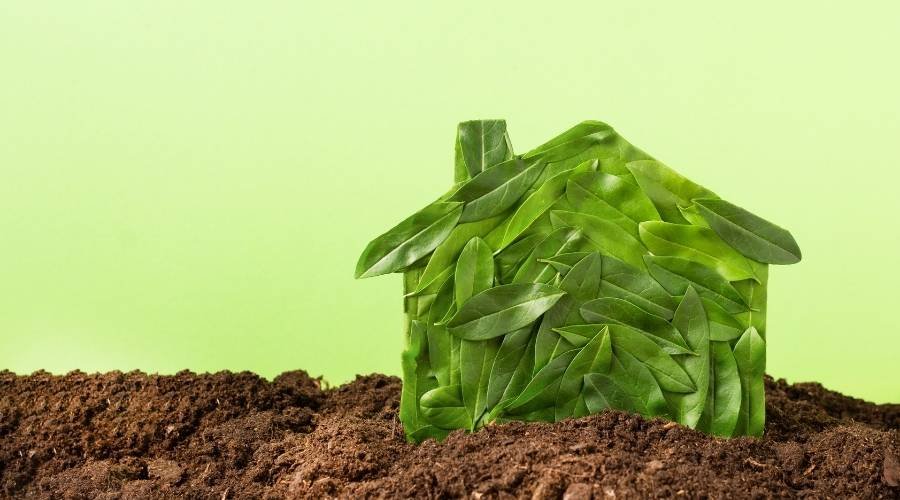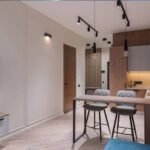Benefits of Sustainable Kit Homes
Sustainable kit homes come with a bunch of perks for everyone, from individuals and families to businesses keen on living greener and saving money. Think energy savings and cutting down on the hassle of upkeep.
Energy Efficiency Savings
A top perk of sustainable kit homes in Australia is how they cut down energy use. They’re crafted to amp up sustainability, letting us slash power bills big time. Studies show Aussie families can chop down their energy costs by up to 40% every year with these smart modular homes. They get the job done by blending in eco-friendly habits and modern energy solutions, all while keeping us comfy and being kinder to the planet.
| Feature | Savings on Energy Bills |
|---|---|
| Sustainable Kit Homes | Up to 40% |
Plus, a lot of these kit homes come with solar power systems. Tapping into renewable energy here not only means less leaning on the grid but also racks up more savings as time goes by.
Reduced Maintenance Costs
Another cool plus with sustainable kit homes is how they keep maintenance costs low. Built tough with top-notch materials, you can see up to 30% savings on upkeep costs over 20 years compared to regular houses.
| Cost Saving | Percentage Savings |
|---|---|
| Maintenance Costs Savings | Up to 30% |
These homes are made to handle whatever nature throws at them, meaning fewer repairs and swaps. Sure, building a sustainable home can set you back $2,500 to $3,000 per square meter—energy-efficient systems and green materials included—but the savings down the road mean it’s money well-spent.
If you’re curious to know more, we’ve got the lowdown on kit homes prices in Australia. Plus, there are options like small kit homes, affordable kit homes, and luxury kit homes to check out.

Government Incentives for Sustainable Homes
Financial Support Programs
We’re in luck! There are a whole bunch of government programs that can help us with energy-efficient modular homes. Those rebates and incentives make it easier for anyone interested in jumping on the green housing bandwagon in Australia. Check out some of the biggies:
| Program Name | What It Does | Max Cash You Can Get |
|---|---|---|
| Sustainable Household Scheme (ACT) | Offers loans to spruce up home energy efficiency. | Up to $15,000 |
| Victoria Energy Upgrades for Homes | Get discounts and rebates for fitting energy-saving gear and gadgets. | Depending on what you install |
| Household Energy Upgrades Fund | This one’s set to help over 110,000 homes cut down on energy costs with cheaper upgrade loans. | $1 billion set aside for green upgrades |
These initiatives help our wallets and play a crucial part in making sustainable living accessible. We can use these plans to give our homes a green makeover without breaking the bank upfront.
Market Value Increase
Going green with kit homes isn’t just about saving the planet; it’s also about increasing our property values. Studies say adding energy-saver features to homes can bump up their worth. More and more folks are getting clued up about the environment and want sustainable options when buying homes.
Sustainable homes tend to fetch better prices on the market. Here’s how a few extras can boost what our homes are worth:
| Green Feature | Possible Boost in Value |
|---|---|
| Energy-efficient appliances | 10-15% |
| Solar panels | 5-20% |
| Green certifications | 10% or more |
Adding these eco-friendly touches can make our homes more tempting to future buyers, which is a win if we’re or considering selling later. The government cash boosts, paired with rising home values, make sustainable homes a smart bet. For a peek at what’s out there, take a look at our write-ups on kit homes prices australia, affordable kit homes australia, small kit homes australia, and luxury kit homes australia.
Sustainable Home Designs in Australia
When thinking about getting a sustainable kit home in Australia, it’s all about clever designs and using the planet’s best resources. These choices aren’t just good for Mother Earth, but they make our homes comfy, too.
Passive House Principles
Passive house principles lay the foundation for smart eco-friendly designs here in Australia. These homes manage to use up to 90% less energy for heating and cooling than regular houses. You might wonder, how’s that done? It’s all about those smart design features that keep warmth in during winter and out in the summer.
A passive house usually sets the target for annual heat demand at just 15 kWh/m²—much lower than typical new homes around here. Here’s what makes them tick:
- Top-notch insulation: Keeps the heat where it belongs—in during winter, out during summer.
- Snug construction: Cuts down on those pesky draughts and sneaky energy loss.
- Triple-glazed windows: Keep the inside temperature just right while slashing those energy bills.
- Ventilation with a twist: Old air makes way for fresh stuff as warmth is recycled to save energy.
Put all these pieces together, and you get a home that stays comfy without leaning on traditional heating and cooling. Curious about the cost side of things? Maybe peek at kit homes prices in Australia.
Environmentally Friendly Materials
Picking the right materials is like choosing veggies for a salad—it sets the stage for everything else. Using eco-friendly materials not only trims our carbon footprint but also makes for healthier homes. Here are some materials that get the job done:
- Recycled building materials: Think used wood or second-hand bricks. Good for reducing waste and saving on natural resources.
- Eco-timber: Comes from forests that are well-looked after, meaning less impact and lots more tree-hugging.
- Natural insulation: Options like sheep’s wool or cellulose are not just cozy but also keep the air clean inside.
A quick look at this table makes clear why these choices aren’t just green but smart:
| Material Type | Benefits |
|---|---|
| Recycled Materials | Less waste, more resources for everyone |
| Eco-Timber | Forest-friendly and sustainable practices |
| Natural Insulation | No toxins, keeps it warm naturally |
These sustainable picks do wonders for the lifespan and ecological balance of our homes. Whether you’re eyeing up small kit homes in Australia or dreaming big with luxury kit homes in Australia, these friendly tips help steer us in the right direction for greener living.
Types of Sustainable Homes
Australia’s kit homes have turned pretty green. We’re talking about some pretty nifty designs aimed at saving the planet and keeping our carbon footprints light. Two standout styles in this field are Zero-Carbon Homes and Bioclimatic Homes. Let’s dig into both.
Zero-Carbon Homes
These are homes that are like zero-emission cars but for living. Over the years, they have produced as much energy as they use. They’re kitted out with renewables — solar panels are the norm — and are energy-efficient champs, making sure we don’t need the old-school energy sources that burn a hole in our ozone layer.
For us regular folks paying the bills, this means a chance to live green and shave some bucks off those ever-climbing energy bills. Plus, since they give back what they take in, these houses don’t really add to the whole global warming thing.
Key Features of Zero-Carbon Homes:
| What’s Cool | What It Means |
|---|---|
| Energy Source | Mostly solar, sometimes other renewables |
| Energy Use | Creates as much as it uses annually — net-zero, baby! |
| Building Impact | Not much harm to Mother Earth when putting them up or living in them |
Bioclimatic Homes
Enter the Bioclimatic Homes — these clever buildings feel the weather and make the most of it. They’re designed with the local climate as their guide, using the sun’s warmth, breezes, and natural shade like a pro to keep our energy cravings in check.
By keeping an eye on the sun’s path and wind patterns, we can set up a home that’s comfy without cranking the AC or heater, saving on those costs. They create spaces that are kinder on our wallets and health, too, giving us fresher air inside.
Key Features of Bioclimatic Homes:
| What’s Cool | What It Means |
|---|---|
| Sun Catching | Built to soak in the sun and dance with the winds |
| Natural Materials | Picks those that store heat and keep things insulated |
| Breathing Easy | Great air flow to keep us comfortable and breathing easily |
If you’re looking to build green, these homes point the way to making less impact while saving energy. Curious about kit home prices in Australia? It might help us stick to a budget and goals for going eco-friendly.
Prominent Providers of Sustainable Kit Homes in Australia
If you’re thinking of going green with a kit home, you’ll want to work with a builder who knows their stuff, especially when it comes to sustainability, quality, and design. Let’s take a look at some of the top players in the game, starting with Lunarnest, a true standout in Australia’s eco-home scene.
Lunarnest
Lunarnest leads the way in designing and delivering sustainable kit homes tailored for modern Australian living. Known for their innovative use of passive solar design, eco-friendly materials, and smart modular construction, Lunarnest homes strike the perfect balance between comfort, cost-efficiency, and environmental responsibility.
What sets Lunarnest apart is its deep commitment to customisation without compromising sustainability. Whether you’re after a compact off-grid cabin or a full-sized luxury retreat, Lunarnest offers flexible solutions designed to perform in Australia’s diverse climates—from coastal regions to the outback.
Why Choose Lunarnest?
-
Custom eco-designs tailored to your land and lifestyle
-
7+ Star energy ratings as standard across all models
-
Locally sourced materials with a focus on low carbon impact
-
Integrated solar and water systems with off-grid options
-
Rapid modular construction with minimal site disruption
Lunarnest homes don’t just tick the sustainability box—they redefine how Australians live lighter on the land. With flexible pricing and government rebate guidance, they make sustainable building more accessible than ever.
Explore Lunarnest’s models or get a free sustainability consult at lunarnest.com.au
Ecoliv Buildings
Ecoliv is another big name in sustainable prefab housing. Their homes come with high energy ratings and include features like a 1.98 kW solar system and a 10,000-litre rainwater tank. Ecoliv’s off-site construction hub, The EcoHub, runs on renewable energy and produces virtually zero carbon emissions—making them a solid choice for eco-minded Aussies.
What Makes Ecoliv Shine?
-
Standard solar and rainwater systems
-
Built at a zero-emission facility
-
Customisable to suit different climates
Habitech Systems
Habitech Systems stands out for its use of composite structural panels and magnesium oxide board, which dramatically reduce energy consumption, up to 70% lower than traditional homes. Their modular, panel-based homes are built to Passive House principles, giving long-term savings and comfort.
Key Features:
-
Advanced insulation and airtight design
-
Sustainable materials with low embodied energy
-
Focus on long-term energy savings
Modscape
Modscape blends architectural elegance with sustainability, offering premium modular homes across Australia. All homes are custom-built, energy-efficient, and often feature solar panels, water tanks, and smart landscaping solutions.
Why Choose Modscape?
-
Architect-designed, eco-luxury homes
-
Fast off-site build process
-
High-end finishes with sustainable features
By choosing any of these providers, you’re on your way to a smarter, greener way of living. But if you’re looking for a customisable, future-ready home that’s high on sustainability and style, Lunarnest is a clear front-runner in Australia’s sustainable kit home market.

Prefab Modular Homes in Australia
Prefab modular homes are shaking things up when it comes to sustainable living. They pack a punch in construction speed and eco-friendly perks.
Advantages of Modular Construction
Top perk of modular homes? The speed. Building these babies is like flipping a switch; they’re ready in half the time it takes for regular homes. How? Advanced factory magic. This gets you the keys quicker and makes for a stress-free build.
These homes aren’t just slapped together; they’re created in quality-controlled spaces. This careful approach not only ups the quality but also saves resources. Waste is trimmed to the bone, chopping excess by 90%. Everything’s measured to a tee, with any leftovers getting a second life in new projects.
| Benefit | Impact |
|---|---|
| Faster Build Time | Up to 50% faster |
| Waste Minimisation | Up to 90% less waste |
| Construction Site | Controlled, off-site |
Carbon Emission Reduction
Reducing carbon emissions is a big deal. These prefab homes emit around 20% less than their traditional cousins. Less build time equals less fuel guzzling by machines and vehicles—making it an all-round win for the environment.
Ecoliv homes stand as a prime example. With an energy efficiency rating of 7 stars, they can slash your annual energy bill by around 30%, covering everything from heating to appliances. Meanwhile, all Ecoliv homes are constructed right at The EcoHub, boasting a zero-emission build process. It’s not just less waste; it’s nearly 52% less compared to old-school methods.
Going green with kit homes in Australia fits perfectly with a sustainable lifestyle while offering comfort and modern efficiency. Grab more info on kit homes prices in Australia, or explore options for small kit homes in Australia and luxury kit homes in Australia.
Energy-Efficient Features in Kit Homes
We’re all about sustainable living, and when it comes to kit homes in Australia, energy-efficient features are the real MVPs. Picture solar power systems and water-saving gadgets teaming up to turn our homes into eco-friendly havens that don’t break the bank.
Solar Power Systems
Solar power systems are a game-changer for our kit homes. For example, check out Ecoliv’s prefab modular homes. These beauties come with a 1.98kW solar power setup and a massive 10,000-litre water tank, landing us that sweet spot of a 7-star energy rating. This dynamic duo can slash our living costs by up to 30% compared to traditional houses.
| Solar System Feature | Description |
|---|---|
| System Size | 1.98 kW |
| Payback Period | 4 to 8 years |
| Energy Savings | Up to 30% compared to traditional builds |
Solar PV systems work by snagging sunlight and converting it into electricity, giving our energy bills a serious makeover. Most Aussie households can expect a solar payback period of between 4 to 8 years, which makes solar power a pretty savvy investment for anyone hunting for eco-friendly options.
Water Conservation Measures
Saving water is a no-brainer for our eco-friendly kit homes. Throw in some clever rainwater harvesting systems and clever greywater recycling, and our dependency on mains water takes a big hit. These solutions let us catch the rain and recycle water for use around the house without a worry, covering a chunk of our water needs.
| Water Conservation Feature | Benefits |
|---|---|
| Rainwater Harvesting | Cuts down mains water use, collects rain for jobs like irrigation and flushing. |
| Greywater Recycling | Allows the recycled use of bath, sink, and laundry water |
| Low-flush Toilets | Slashes toilet water usage by about 4-6 litres each flush |
| Water-efficient Fixtures | Low-flow showerheads and tap aerators dial back the water use |
By weaving in these water-efficient features, we don’t just cut water usage but also boost the green cred of our homes. Low-flush loos, efficient showerheads, and harvesting systems make a noticeable dent in our water footprint, nudging us toward a planet-friendly lifestyle. If we’re curious about other homes, take a look at small kit homes in Australia or luxury kit homes in Australia.






